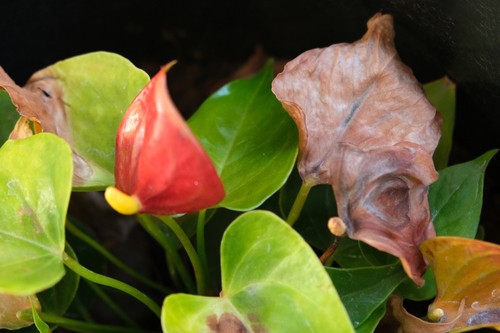Anthuriums are popular houseplants known for their striking, heart-shaped flowers and glossy, green leaves. However, despite their beauty, anthuriums can be quite finicky and require specific care to thrive. One of the most common issues for this magnificent plant owners is Anthurium Leaves Turning Yellow Brown
Yellow or brown leaves on anthurium plants are often a sign of stress or damage. There are several reasons why anthurium leaves may turn yellow or brown, including overwatering, underwatering, improper lighting, pests or diseases, and poor soil quality. Understanding the cause of the problem is crucial to finding a solution and restoring the health of the plant.
Proper care and maintenance are essential for preventing yellow or brown leaves on anthurium plants. This includes providing the right amount of water, light, and humidity, choosing the right soil, and fertilizing appropriately. With the right care, anthuriums can thrive and bring a touch of tropical beauty to any home.
Key Takeaways
- Yellow or brown leaves on anthurium plants are a common issue that can be caused by a variety of factors, including overwatering, underwatering, improper lighting, pests or diseases, and poor soil quality.
- Proper care and maintenance, including providing the right amount of water, light, and humidity, choosing the right soil, and fertilizing appropriately, are crucial for preventing yellow or brown leaves on anthurium plants.
- With the right care, anthuriums can thrive and bring a touch of tropical beauty to any home.
You also shouldn’t miss:
Understanding Anthuriums
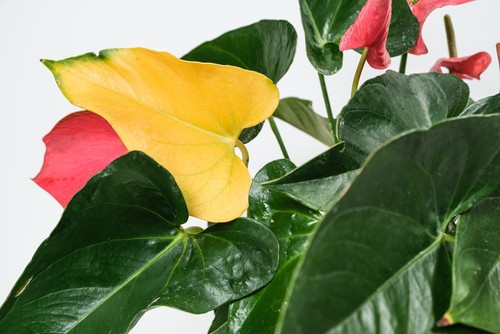
Anthuriums are a popular choice for houseplants due to their unique and attractive appearance. These tropical plants are native to the rainforests of South America and are known for their glossy, heart-shaped leaves and vibrant flowers. Anthuriums are also commonly referred to as “Flamingo Flower” or “Tailflower” due to their distinctive shape.
Anthurium plants are relatively easy to care for, but they do have specific requirements that need to be met to ensure their health and longevity. They prefer bright, indirect light and warm temperatures between 60-90°F. Anthuriums also require high humidity levels, so it is essential to keep them in a moist environment.
One of the most common issues that Anthurium owners face is yellow or brown leaves. This can be caused by a variety of factors, including overwatering, underwatering, incorrect lighting conditions, and low humidity levels. It is essential to identify the cause of the problem to determine the appropriate course of action.
Anthuriums are sensitive to overwatering, and their roots can quickly become waterlogged, leading to yellow or brown leaves. On the other hand, underwatering can cause the leaves to wilt and turn yellow. It is crucial to strike a balance between these two extremes and ensure that the soil is moist but not overly wet.
Incorrect lighting conditions can also cause Anthurium leaves to turn yellow or brown. These plants prefer bright, indirect light and can be damaged by direct sunlight. If the leaves are turning yellow or brown, it may be necessary to move the plant to a different location with better lighting conditions.
Finally, low humidity levels can cause Anthurium leaves to turn yellow or brown. These tropical plants require high humidity levels to thrive, and if the air is too dry, the leaves can become dehydrated and damaged. It may be necessary to increase the humidity levels around the plant by misting it regularly or using a humidifier.
Anthurium Care Basics
Anthuriums are tropical plants that require specific care to thrive. Proper care can help prevent issues such as yellowing or browning leaves. Here are some basic care tips for Anthuriums:
1. Watering
One of the most important aspects of Anthurium care is watering. Overwatering can cause root rot, while underwatering can lead to dry or yellowing leaves. It is recommended to water Anthuriums when the top inch of soil is dry to the touch.
The frequency of watering will depend on factors such as humidity levels and temperature. It is important to avoid letting the plant sit in standing water, as this can cause root rot.
2. Light

Anthuriums thrive in bright, indirect sunlight. Direct sunlight can cause the leaves to burn, while too little sunlight can lead to slow growth and fewer blooms. It is important to find a location that provides bright, indirect sunlight for the plant.
3. Humidity
Anthuriums are native to tropical environments and require high humidity levels to thrive. Low humidity levels can cause issues such as yellowing leaves or stunted growth. It is recommended to keep the plant in a humid environment, such as a bathroom or near a humidifier. Misting the leaves can also help increase humidity levels.
4. Fertilization
Fertilization is an important aspect of Anthurium care. A balanced, water-soluble fertilizer can help promote healthy growth and prevent yellowing or browning leaves. It is recommended to fertilize Anthuriums every two to four weeks during the growing season, and reduce fertilization during the dormant season.
Anthurium Leaves Turning Yellow Brown – 7 Common Problems
Anthurium leaves turning yellow or brown can be a sign of various issues. Here are some of the most common causes of yellow and brown leaves in Anthurium plants:
1. Overwatering
Overwatering is one of the most common causes of yellowing and browning of Anthurium leaves. When the plant is overwatered, the roots become waterlogged, which can lead to root rot. Root rot prevents the plant from absorbing nutrients, causing the leaves to turn yellow or brown and eventually fall off.
2. Underwatering
Underwatering can also cause yellowing and browning of Anthurium leaves. When the plant does not receive enough water, the leaves will start to dry out and turn yellow. In more severe cases, the leaves will turn brown and fall off.
3. Direct Sunlight
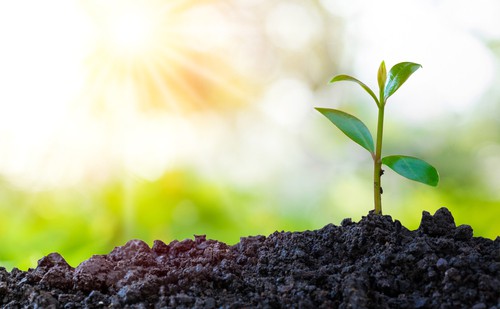
Exposure to direct sunlight can cause sunburn and brown spots on the Anthurium leaves. The plant prefers bright, indirect light, so it is essential to keep it away from direct sunlight.
4. Temperature Stress
Anthurium plants are sensitive to temperature changes. When the temperature is too high or too low, the leaves can turn yellow or brown. It is essential to keep the plant in a room with a consistent temperature.
5. Nutrient Deficiency
A lack of nutrients, particularly nitrogen, can cause yellowing of the Anthurium leaves. The leaves will turn yellow and start to droop when the plant is not receiving enough nutrients.
6. Salts Buildup
Excessive salts buildup in the soil can cause chlorosis, which leads to yellowing of the leaves. It is essential to flush the soil regularly to prevent salt buildup.
7. Diseases
Anthurium plants are susceptible to various diseases that can cause yellowing and browning of the leaves. Common diseases include bacterial blight, root rot, and fungal infections.
Role of Environmental Factors
Anthurium plants are native to tropical regions, and they thrive in warm and humid environments. However, environmental factors can play a significant role in causing the leaves of anthurium plants to turn yellow or brown. Here are some of the most common environmental factors that can affect the health of anthurium plants and cause their leaves to discolor:
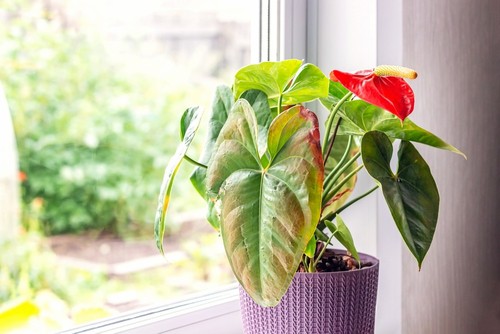
1. Temperature
Anthurium plants prefer temperatures between 60 and 90 degrees Fahrenheit. If the temperature drops below 60 degrees Fahrenheit, the plant may suffer from cold damage, which can cause the leaves to turn yellow or brown.
Similarly, if the temperature rises above 90 degrees Fahrenheit, the leaves may become scorched and turn brown.
2. Humidity
Humidity is another critical factor that can affect the health of anthurium plants. These plants require high humidity levels to thrive, and low humidity levels can cause the leaves to dry out and turn yellow or brown. On the other hand, excessive humidity can lead to fungal growth, which can cause the leaves to rot and turn brown.
3. pH
Anthurium plants prefer slightly acidic soil with a pH between 5.5 and 6.5. If the soil pH is too high or too low, the plant may not be able to absorb the necessary nutrients, which can cause the leaves to turn yellow or brown.
4. Drainage
Proper drainage is essential for anthurium plants. If the soil is too wet, the roots may become waterlogged, which can cause the leaves to turn yellow or brown. Additionally, poor drainage can lead to root rot, which can cause the leaves to wilt and turn brown.
5. Humidity Issues
Humidity issues can also cause problems for anthurium plants. If the humidity is too low, the leaves may dry out and turn yellow or brown. If the humidity is too high, the leaves may become waterlogged and turn brown.
6. Temperature Issues
Temperature issues can also affect the health of anthurium plants. If the temperature is too low, the leaves may become damaged and turn yellow or brown. If the temperature is too high, the leaves may become scorched and turn brown.
Significance of Proper Lighting
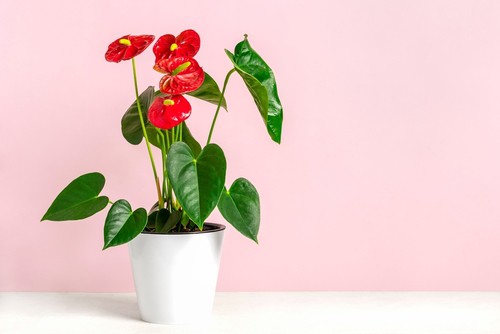
Anthurium plants require proper lighting to maintain healthy growth and prevent yellow or brown leaves. The amount of light an Anthurium plant needs depends on the species. Generally, Anthurium plants prefer bright, indirect light, but too much direct sunlight can scorch the leaves and cause them to turn brown.
Direct sunlight exposure is one of the most common causes of brown or yellow leaves in Anthurium plants. If the plant is placed in an area with too much direct sunlight, it can cause sunburn on the leaves and lead to discoloration. It is recommended to place the plant in a well-lit area with indirect sunlight to prevent sunburn.
On the other hand, if the Anthurium plant is not receiving enough light, it can also cause yellow or brown leaves. If the plant is not getting enough light, it may not be able to produce enough energy to maintain healthy growth and the leaves may start to turn yellow.
Proper lighting is crucial for Anthurium plants to maintain healthy growth and prevent yellow or brown leaves. It is recommended to place the plant in a well-lit area with indirect sunlight to prevent sunburn and provide the necessary energy for healthy growth.
Importance of Appropriate Watering
Anthurium plants require appropriate watering to thrive and maintain their lush green appearance. Overwatering or underwatering can cause the leaves to turn yellow or brown, leading to the plant’s death. Therefore, it is crucial to understand the watering requirements of anthurium plants.
Watering
Anthurium plants require watering when the top inch of soil is dry. The frequency of watering depends on various factors such as humidity, temperature, and light intensity. In general, anthurium plants require watering once a week. However, during summers, when the temperature is high, the frequency of watering may increase.
Overwatering
Overwatering is one of the most common reasons for anthurium leaves turning yellow or brown. When the soil is saturated with water, the roots of the plant start to rot, leading to the plant’s death. Signs of overwatering include yellowing leaves, wilting, and a foul smell coming from the soil.
To avoid overwatering, it is essential to ensure proper drainage of the soil. The potting soil should be well-drained and porous, allowing excess water to drain out quickly. Moreover, standing water should be removed from the saucer or tray underneath the pot to prevent the roots from sitting in water.
Underwatering

Underwatering is another reason for anthurium leaves turning yellow or brown. When the plant does not receive enough water, the leaves start to wilt and turn yellow. In severe cases, the leaves may dry out and fall off.
To avoid underwatering, it is essential to water the plant adequately. The top inch of soil should be dry before watering. Moreover, the plant should be watered thoroughly, allowing the water to penetrate deep into the soil.
Standing Water
Standing water is another reason for anthurium leaves turning yellow or brown. When the pot is placed in standing water, the soil becomes saturated with water, leading to root rot and the plant’s death.
To avoid standing water, the pot should be placed on a saucer or tray with pebbles or gravel. The pebbles or gravel allow the excess water to drain out, preventing the soil from becoming saturated.
Dealing with Pests and Diseases
Anthurium plants are susceptible to a range of pests and diseases that can cause damage to the leaves and flowers. It is important to identify and treat these issues promptly to prevent further damage. Here are some common pests and diseases that affect Anthurium plants and how to deal with them:
Pests
Anthurium plants can be affected by a range of pests, including mealybugs, spider mites, aphids, and scales. These pests can cause damage to the leaves and flowers, and can even lead to the death of the plant if left untreated.
To deal with these pests, it is recommended to shoot them off the leaves with water or scrub them lightly with a gentle brush and horticultural soap. Prevent pest infestations by never letting Anthurium plants sit in water. Additionally, it is important to regularly inspect the plant for pests and treat them immediately to prevent further damage.
Bacterial Blight
Bacterial blight is a common disease that affects Anthurium plants. It is caused by the bacteria Xanthomonas campestris and can cause yellowing and wilting of the leaves, as well as brown spots on the leaves and flowers.
To treat bacterial blight, it is recommended to remove any infected plants, destroy any soil or plant debris, and treat the soil with a nematode-killing agent. Additionally, it is important to maintain good hygiene practices, such as washing hands and tools before and after handling plants, to prevent the spread of the disease.
Leaf Blight
Leaf blight is another common disease that affects Anthurium plants. It is caused by the fungus Cylindrocladium spathiphylli and can cause yellowing and wilting of the leaves, as well as brown spots on the leaves and flowers.
To treat leaf blight, it is recommended to remove any infected plants, destroy any soil or plant debris, and treat the soil with a fungicide. Additionally, it is important to maintain good hygiene practices to prevent the spread of the disease.
Choosing the Right Soil

Anthurium plants require well-draining soil that retains moisture without becoming waterlogged. Choosing the right soil mix is crucial for the health of your plant. Here are some factors to consider when selecting soil for your anthurium:
1. Soil Mix
The ideal soil mix for anthurium plants is a mixture of peat moss, perlite, and soil mix. Peat moss is an organic material that retains moisture well, while perlite provides good drainage. Soil mix provides the necessary nutrients for the plant to grow.
2. Peat Moss
Peat moss is a common ingredient in soil mixes for anthurium plants. It is an organic material that helps to retain moisture in the soil. However, it is important to note that peat moss is not a sustainable resource. Some gardeners prefer to use coconut coir instead of peat moss as a more environmentally friendly alternative.
3. Perlite
Perlite is a volcanic glass that is added to soil mixes to improve drainage. It is a lightweight material that helps to prevent soil compaction and allows air to circulate around the roots of the plant. Perlite is an essential ingredient in soil mixes for anthurium plants.
4. Soil Mixture
Soil mix is an essential ingredient in soil mixes for anthurium plants. It provides the necessary nutrients for the plant to grow and thrive. It is important to choose a high-quality soil mix that is formulated specifically for anthurium plants.
5. Bad Soil
Using bad soil can lead to a variety of problems for anthurium plants, including yellowing and browning of leaves. Bad soil can be too dense, too alkaline, or too acidic, which can all affect the health of the plant. It is important to choose a soil mix that is well-draining and provides the necessary nutrients for the plant to grow.
Nutrition and Fertilization
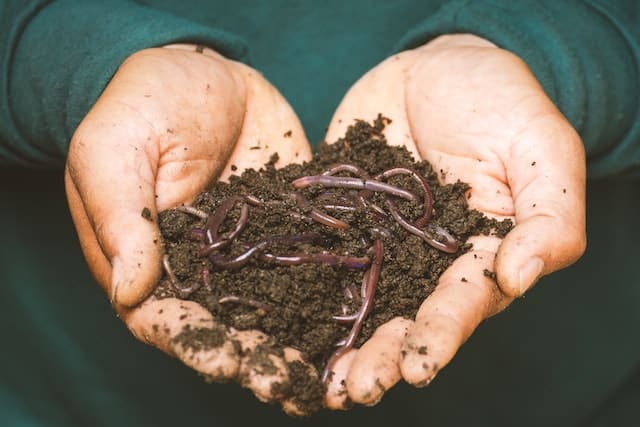
One of the most common reasons for anthurium leaves turning yellow or brown is lack of nutrition. Anthurium plants require a balanced and consistent supply of nutrients to thrive.
Fertilizing your anthurium plant is an essential part of its care routine. Fertilizer provides the necessary nutrients for the plant to grow and produce healthy foliage and flowers. It is recommended to fertilize your anthurium plant every two to three months during the growing season.
When choosing a fertilizer, it is important to choose a water-soluble fertilizer that is high in nitrogen and phosphorus and low in potassium.
Nitrogen is essential for healthy foliage growth, while phosphorus is necessary for flower production. Potassium is also important, but too much of it can cause salt buildup in the soil, leading to root damage and yellowing leaves.
Over-fertilizing can also lead to yellowing leaves. Excess fertilizer can cause salt buildup in the soil, which can lead to root damage and nutrient deficiencies. It is important to follow the recommended dosage on the fertilizer label and avoid applying fertilizer too frequently.
Pruning can also help improve the plant’s nutrient uptake. Removing dead or damaged leaves and flowers can redirect the plant’s energy to producing healthy foliage and flowers.
Pruning and Maintenance
Anthurium plants require regular pruning and maintenance to keep them healthy and looking their best. Pruning helps to remove dead or yellowing leaves, promote new growth, and maintain the plant’s shape. In this section, we will cover the basics of pruning and maintenance for anthurium plants.
Pruning
Pruning anthurium plants is a simple process that can be done with a pair of sharp pruning shears or scissors. Before pruning, it’s important to sterilize the tools with rubbing alcohol or a disinfectant to prevent the spread of disease.
To prune an anthurium plant, simply cut the stem of the leaf or flower you would like to remove as close to the base as possible. If the leaf or flower is still green, it can be composted. If it is yellow or brown, it should be discarded to prevent the spread of disease.
Regular pruning is essential for the health of anthurium plants. It helps to promote new growth, prevent overcrowding, and prevent the spread of disease. Pruning should be done as needed throughout the year.
Maintenance
In addition to pruning, anthurium plants require regular maintenance to keep them healthy and looking their best. Here are some tips for maintaining anthurium plants:
- Watering: Anthurium plants require regular watering to keep the soil moist but not waterlogged. Water the plant when the top inch of soil feels dry to the touch.
- Fertilizing: Anthurium plants benefit from regular fertilization with a balanced fertilizer. Fertilize the plant once a month during the growing season.
- Light: Anthurium plants thrive in bright, indirect light. Avoid direct sunlight, which can burn the leaves.
- Humidity: Anthurium plants require high humidity to thrive. Use a humidifier or place a tray of water near the plant to increase humidity.
- Pest control: Anthurium plants are susceptible to pests such as spider mites and mealybugs. Regularly inspect the plant for signs of infestation and treat as needed with an insecticidal soap or neem oil.
By following these tips for pruning and maintenance, anthurium plants can thrive and provide beautiful foliage and flowers for years to come.
Dealing with Humidity Issues

Anthuriums are tropical plants that thrive in humid environments. When the humidity level drops below the ideal range, anthurium leaves may start to turn yellow or brown. To prevent this from happening, it is important to maintain proper humidity levels around your anthurium plants.
One way to increase humidity levels is to use a humidifier. A humidifier can help to add moisture to the air, which can be especially helpful during the winter months when indoor heating can cause the air to become dry. When using a humidifier, it is important to monitor the humidity levels to ensure that they stay within the ideal range.
Another way to increase humidity levels is to mist your anthurium plants regularly. Misting can help to add moisture to the air around your plants, which can help to prevent the leaves from turning yellow or brown. When misting, be sure to use room temperature water and avoid getting water on the flowers or leaves.
If you are dealing with humidity issues, it is important to identify the cause of the problem. Improper humidity levels can be caused by a variety of factors, including low humidity in the home, poor air circulation, or improper watering. Once you have identified the cause of the problem, you can take steps to address it and restore proper humidity levels.
In summary, maintaining proper humidity levels is essential for the health of your anthurium plants. Using a humidifier, misting your plants regularly, and identifying and addressing the cause of humidity issues can help to prevent the leaves from turning yellow or brown.
Understanding Anthurium Life Cycle
Anthuriums are tropical plants that are native to Central and South America. They are popular houseplants because of their beautiful, heart-shaped flowers that come in a variety of colors, including red, pink, and white. However, like any other plant, anthuriums have a life cycle that affects their growth and health.
The life cycle of anthuriums starts with the germination of their seeds, which can take up to six months. Once the seeds have germinated, the plant will go through several stages of growth, including the vegetative stage, the reproductive stage, and the senescence stage.
During the vegetative stage, the plant will focus on growing leaves and roots. This stage can last for several years, and during this time, the plant will need plenty of water and nutrients to support its growth.
The reproductive stage is when the plant starts to produce flowers. This stage can last for several months, and during this time, the plant will need plenty of light and nutrients to support the development of its flowers.
The senescence stage is when the plant starts to decline in health and eventually dies. This stage can last for several years, and during this time, the plant will need less water and nutrients as it prepares for the end of its life cycle.
Understanding the life cycle of anthuriums is important for their care and maintenance. By providing the plant with the right amount of water, nutrients, and light at each stage of its life cycle, you can help ensure that it grows and blooms to its full potential.
Frequently Asked Questions
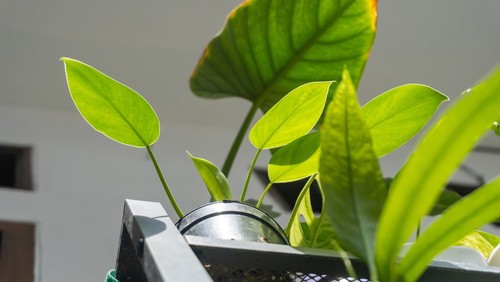
Why are the edges of my Anthurium leaves turning yellow?
The edges of Anthurium leaves turning yellow can be caused by several factors such as over or under-watering, low humidity, pests, or disease. It is important to determine the root cause of the problem to properly address it.
If overwatering is the issue, reduce watering frequency and allow the soil to dry out between watering. If low humidity is causing the problem, consider using a humidifier or placing a tray of water near the plant.
How can I prevent my Anthurium flowers from turning yellow?
Anthurium flowers can turn yellow due to several reasons such as over-fertilization, low humidity, or aging of the flower. To prevent yellowing of Anthurium flowers, avoid over-fertilizing and maintain proper humidity levels. Additionally, remove any flowers that have started to wilt or turn yellow to prevent the spread of disease.
What causes Anthurium leaves to turn light green?
Anthurium leaves can turn light green due to a lack of nutrients or sunlight. Ensure that the plant is receiving adequate sunlight and fertilize as necessary to provide the plant with the necessary nutrients.
How can I treat my Queen Anthurium’s yellow leaves?
Yellowing of Queen Anthurium leaves can be caused by several factors such as over or under-watering, low humidity, pests, or disease. To treat yellowing leaves, determine the root cause of the problem and address it accordingly.
If overwatering is the issue, reduce watering frequency and allow the soil to dry out between watering. If low humidity is causing the problem, consider using a humidifier or placing a tray of water near the plant.
What causes brown spots on Anthurium leaves?
Brown spots on Anthurium leaves can be caused by several factors such as fungal or bacterial infections, pests, or over-fertilization. To prevent brown spots, ensure that the plant is not over-fertilized and is receiving adequate sunlight and airflow.
Additionally, remove any infected leaves to prevent the spread of disease.
Why is the stem of my Anthurium turning yellow?
The stem of an Anthurium can turn yellow due to several reasons such as over or under-watering, low humidity, or disease. To prevent yellowing of the stem, ensure that the plant is receiving adequate water and humidity levels. Additionally, remove any infected leaves or stems to prevent the spread of disease.

Hey, I’m Lisa and I’ve been an avid gardener for over 30 years. I love writing, talking and living in the garden! Feel free to connect with me on my socials below

